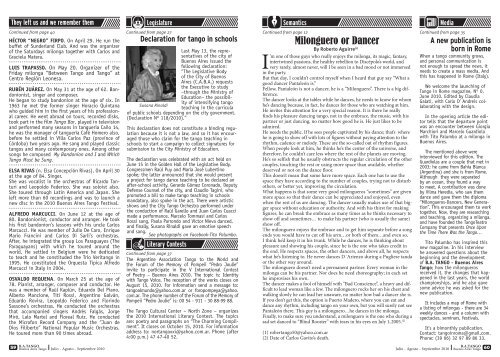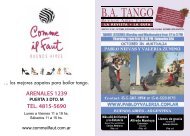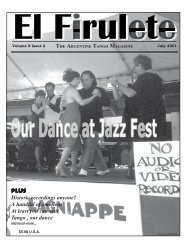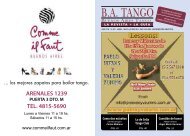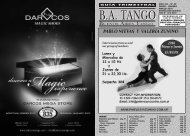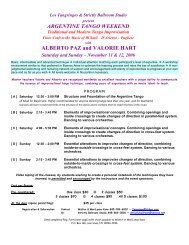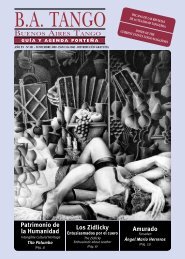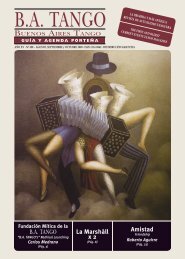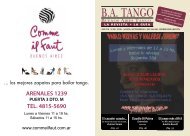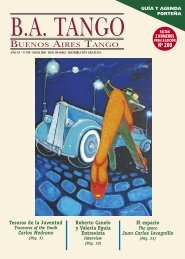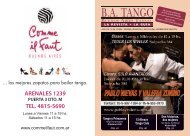Salón Boedo Tango Milonguero o Bailarín Corazonada - Planet Tango
Salón Boedo Tango Milonguero o Bailarín Corazonada - Planet Tango
Salón Boedo Tango Milonguero o Bailarín Corazonada - Planet Tango
Create successful ePaper yourself
Turn your PDF publications into a flip-book with our unique Google optimized e-Paper software.
They left us and we remember them<br />
Continued from page 40<br />
HÉCTOR “NEGRO” FIRPO. On April 29. He run the<br />
buffet of Sunderland Club. And was the organizer<br />
of the Saturdays milonga together with Carlos and<br />
Graciela Matera.<br />
LUIS TRAPASSO. On May 20. Organizer of the<br />
Friday milonga “Between <strong>Tango</strong> and <strong>Tango</strong>” at<br />
Centro Región Leonesa.<br />
RUBÉN JUÁREZ. On May 31 at the age of 62. Bandonionist,<br />
singer and composer.<br />
He began to study bandonion at the age of six. In<br />
1963 he met the former singer Horacio Quintana<br />
who guided him in the first years of his professional<br />
career. He went abroad on tours, recorded disks,<br />
took part in the film <strong>Tango</strong> Bar, played in television<br />
and performed many seasons in tanguería Caño 14,<br />
he was the manager of tanguería Café Homero also,<br />
before he settled in Villa Carlos Paz (province of<br />
Córdoba) two years ago. He sang and played classic<br />
tangos and many contemporary ones. Among other<br />
songs he composed My Bandonion and I and Which<br />
<strong>Tango</strong> Must be Sung.<br />
ELSA RIVAS (n. Elsa Concepción Rivas). On April 30<br />
at the age of 84. Singer.<br />
She was vocalist in the orchestras of Ricardo Tanturi<br />
and Leopoldo Federico. She was soloist also.<br />
She toured through Latin America and Japan. She<br />
left more than 60 recordings and was to launch a<br />
new disc in the 2010 Buenos Aires <strong>Tango</strong> Festival.<br />
ALFREDO MARCUCCI. On June 12 at the age of<br />
80. Bandonionist, conductor and arranger. He took<br />
his first bandonion’s lessons with his uncle Carlos<br />
Marcucci. He was member of Julio De Caro, Enrique<br />
Mario Francini and Carlos Di Sarli’s orchestras.<br />
After, he integrated the group Los Paraguayos (The<br />
Paraguayans) with which he toured around the<br />
world. He settled in Belgium were he dedicated<br />
to teach and he constituded the Trío Veritango in<br />
1995. He constituted the Orquesta Típica Alfredo<br />
Marcucci in Italy in 2004.<br />
OSVALDO REQUENA. On March 25 at the age of<br />
78. Pianist, arranger, composer and conductor. He<br />
was a member of Raúl Kaplún, Eduardo Del Piano,<br />
Alberto Mancione, Tití Rossi, Argentino Galván,<br />
Eduardo Rovira, Leopoldo Federico and Florindo<br />
Sassone’s orchestras. He conducted the orchestras<br />
that accompanied singers Andrés Falgás, Jorge<br />
Miró, Lalo Martel and Floreal Ruiz. He conducted<br />
the Microfon Record Company and the “Juan de<br />
Dios Filiberto” National Popular Music Orchestras.<br />
He toured more than 90 times abroad.<br />
59 B.A.TANGO<br />
Buenos Aires <strong>Tango</strong> Julio - Agosto - Septiembre 2010<br />
Legislature<br />
Continued from page 27<br />
Declaration for tango in schools<br />
Last May 13, the representatives<br />
of the city of<br />
Buenos Aires issued the<br />
following declaration:<br />
“The Legislative Body<br />
of the City of Buenos<br />
Aires (C.A.B.A.) requests<br />
the Executive to study<br />
–through the Ministry of<br />
Education– the possibility<br />
of intensifying tango<br />
Susana Rinaldi<br />
teaching in the curricula<br />
of public schools depending on the city government.<br />
(Declaration Nº 118/2010).”<br />
This declaration does not constitute a binding regulation<br />
because it is not a law, and so it has encouraged<br />
those who claim for the tango teaching in<br />
schools to start a campaign to collect signatures for<br />
submission to the City Ministry of Education.<br />
The declaration was celebrated with an act held on<br />
June 15 in the Golden Hall of the Legislative Body.<br />
Congressmen Raúl Puy and María José Lubertino<br />
spoke; the latter announced that she would present<br />
a project for tango dance teaching to be declared an<br />
after-school activity. Gerardo Gómez Coronado, Deputy<br />
Defense Counsel of the city, and Claudio Tagini, who<br />
promoted a bill to make tango teaching in schools<br />
mandatory, also spoke in the act. There were artistic<br />
shows and the City <strong>Tango</strong> Orchestra performed under<br />
the conduction of Raúl Garello and Juan Carlos Cuacci<br />
made a performance. Marcelo Tommasi and Carlos<br />
Rossi sang, Paola Parrondo and Víctor Nieva danced,<br />
and finally, Susana Rinaldi gave an emotive speech<br />
and sang.<br />
See photographs on Facebook-Tito Palumbo.<br />
Literary Contests<br />
Continued from page 37<br />
The Argentine Association <strong>Tango</strong> to the World and<br />
the Forum of the Memory of Pompeii “Pedro Joulie”<br />
invite to participate in the V International Contest<br />
of Poetry – Buenos Aires 2010. The topic is: Identity<br />
with <strong>Tango</strong> Voice. The reception of the works closes on<br />
August 15, 2010. For information send a message to:<br />
tangoalmundo@yahoo.com.ar or foropompeya@yahoo.<br />
com.ar. The phone number of the Forum of the Memory of<br />
Pompeii “Pedro Joulie” is: 00 54 - 911 - 30 88-99 88.<br />
The <strong>Tango</strong> Cultural Center – North Zone – organizes<br />
the 2010 International Literary Contest. The topics<br />
are: poetry and paragraphs on “The Charming Compliment”.<br />
It closes on October 15, 2010. For information<br />
address to: nortangoxxi@yahoo.com.ar. Phone (after<br />
4:00 p.m.) 47 47-40 52.<br />
I<br />
Semantics<br />
<strong>Milonguero</strong> or Dancer<br />
By Roberto Aguirre (1)<br />
Continued from page 12<br />
’m one of those guys who really enjoys the milonga, its magic, fantasy,<br />
intertwined passions, the healthy rebellion to Discépolo’s world, and<br />
very rarely, almost never, will I be seen in a bad mood or not immersed<br />
in the party.<br />
But that day, I couldn’t control myself when I heard that guy say “What a<br />
good dancer Pantaleón is.”<br />
Fellow, Pantaleón is not a dancer, he is a “<strong>Milonguero</strong>”. There is a big difference.<br />
The dancer looks at the tables while he dances, he needs to know for whom<br />
he’s dancing because, in fact, he dances for those who are watching at him.<br />
He invites this attention for a very special reason. It is there he really<br />
finds his pleasure dancing tango, not in the embrace, the music, with his<br />
partner or just dancing, no matter how good he is. He just likes to be<br />
admired.<br />
He needs the public. If he sees people captivated by his dance; that’s where<br />
he is going to show off with lots of figures without paying attention to the<br />
rhythm, cadence or melody. These are the so-called out of rhythm figures.<br />
When people look at him, he thinks he’s the center of the universe, and<br />
therefore, he couldn’t care less where the rest of the planets are moving.<br />
He’s so selfish that he usually obstructs the regular circulation of the other<br />
couples, touching the rest or using more space than available, whether<br />
deserved or not on the dance floor.<br />
This doesn’t mean that some have more space. Each one has to use the<br />
space they have according to the number of couples, trying not to disturb<br />
others, or better yet, improving the circulation.<br />
What happens is that some very good milongueros “sometimes” are given<br />
more space so that their dance can be appreciated and enjoyed, even<br />
when the rest of us are dancing. The dancer usually makes use of that bigger<br />
space without education or authority. And with his thirst for making<br />
figures, he can break the embrace as many times as he thinks necessary to<br />
show off and sometimes… to make his partner (who is usually the same)<br />
show off.<br />
The milonguero enjoys the embrace and to get him separate before a song<br />
ends you would have to cut off his arm…or both of them…and even so,<br />
I think he’d keep it in his trunk. While he dances, he is thinking about<br />
pleasure and showing his couple, since he is the one who takes credit in<br />
the end. He respects spaces, the other dancers, and above all, he respects<br />
what he’s listening to. He never dances D´Arienzo during a Pugliese tanda<br />
or the other way around.<br />
The milonguero doesn’t need a permanent partner. Every woman in the<br />
milonga can be his partner. Nor does he need choreography; in each set<br />
he improvises his own.<br />
The dancer makes a fool of himself with “Bad Conscience”, a heavy and difficult<br />
to lead woman like a few. The milonguero rocks her on his chest and<br />
walking slowly he can lead her unaware, no matter how bad a dancer she is.<br />
If you don’t get this, the option is Puerto Madero, where you can eat and<br />
dance any rhythm, including tango on your own, but you will surely not see<br />
Pantaleón there. This guy is a milonguero…he dances in the milonga.<br />
Finally, to make sure you understand, a milonguero is the one who during a<br />
sad set danced to “Blind Rooster” with tears in his eyes on July 1, 2005. (2)<br />
(1) robertango50@yahoo.com.ar<br />
(2) Date of Carlos Gavito’s death.<br />
Media<br />
Continued from page 35<br />
A new publication is<br />
born in Rome<br />
When a tango community grows,<br />
and personal communication is<br />
not enough to spread the news, it<br />
needs to create a mass media. And<br />
this has happened in Rome (Italy).<br />
We welcome the launching of<br />
<strong>Tango</strong> in Rome magazine, Nº 0,<br />
June 2010. Edited by Claudia<br />
Galati, with Carlo D’ Andreis collaborating<br />
with the design.<br />
In the opening article the editor<br />
tells that the departure point<br />
was an encounter between Giorgia<br />
Marchiori and Marcelo Guardiola<br />
with Tito Palumbo at a milonga in<br />
Buenos Aires.<br />
The mentioned above were<br />
interviewed for this edition. The<br />
Guardiolas are a couple that met in<br />
2003; he came from Bahía Blanca<br />
(Argentina) and she is from Rome.<br />
Although they were separated<br />
by an ocean, they found a way<br />
to meet. A contribution was done<br />
by Vilma Heredia, who saw them<br />
dance and gave them the diploma<br />
“<strong>Milonguero</strong>s-Dancers. New Generation”.<br />
This encouraged them to work<br />
together. Now, they are researching<br />
and teaching, organizing a milonga,<br />
and have founded the <strong>Tango</strong>Teatro<br />
Company that presents Once Upon<br />
the Time There Was the <strong>Tango</strong>…<br />
Tito Palumbo has inspired this<br />
new magazine. In his interview<br />
he answered questions about the<br />
beginning and the development<br />
of B.A. TANGO - Buenos Aires<br />
<strong>Tango</strong>; how the milongueros<br />
received it, the changes that happened<br />
in the last years, the world<br />
championships, and he also gave<br />
some advice he was asked for the<br />
new publication.<br />
It includes a map of Rome with<br />
a listing of milongas - there are 34<br />
weekly dances - and a column with<br />
spectacles, seminars, festivals.<br />
It’s a bimonthly publication.<br />
Contact: tangoinroma@gmail.com.<br />
Phone: (39 06) 32 97 89 86 33.<br />
Julio - Agosto - Septiembre 2010<br />
B.A.TANGO<br />
Buenos Aires <strong>Tango</strong><br />
60


